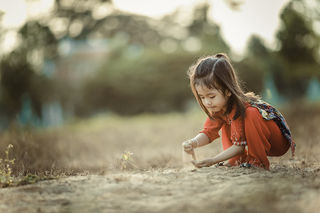Trust
How to Raise a Securely Attached Child
Simple, practical tips for developing emotional trust.
Posted March 22, 2017 Reviewed by Devon Frye

As a parent, one of the best things you can do for your child is help them develop what's known as a "secure attachment style."
You’ll know your child has a secure style if he or she is a confident explorer but regularly returns to you for connection and comfort.
Having a secure style makes forming and maintaining relationships easier throughout a person's life course. This is because people with secure styles trust their "attachment figures" (whether that's a parent, teacher, or romantic partner) to provide support when they need it. The secure child feels empowered to explore the world because they know that when they need to retreat back to Mom or Dad (or their future relationship partner), that person will be there with open arms.
Check out the following simple, practical tips for raising a securely attached child:
-
Helping a child develop a secure style is about your child, not a generic child. It's mostly about responding to their cues. The most basic level of this is being responsive to their physical cues. Help you child learn how to accurately recognize when they're hungry, tired, etc.
-
Make sure your child knows they can get your attention when they’re feeling frightened, or want to share positive emotions. The latter is especially important. Emotional support is not just about when things go wrong. Responsiveness to their positive emotions is equally important.
-
Use eye contact as a way of connecting with your child.
-
Greet your child mindfully after a separation, such as if you've been running errands without them. Pay attention to when they’ve finished reconnecting with you. For example, if you work outside the home, notice how much reconnecting time your child needs with you before you get started on dinner or get distracted with other activities. This may vary day to day.
-
If you mess up, apologize, but not excessively. Attachment style is fundamentally about trust. Consider how genuine apologies enhance trust in adult relationships. Apologies show that the apologizer cares about your feelings. Building trust and secure attachment are not about never getting things wrong as a parent. It's about repairing trust when you do.
-
Don’t sneak out the door when your child isn't looking. Be predictable. If your child is naturally anxious, routines will help your child know what to expect. For example, routines for parting and greeting each other, or routines for staying at Grandma's house.
 Source: Unsplash. Creative Commons Zero.
Source: Unsplash. Creative Commons Zero. -
Children with avoidant styles look like they don't care when their parent leaves them but studies of their physiology tell a different story. If your child seems very self-reliant, to the point that they barely notice when you leave them, consider that it may be that their distress isn't noticeable rather than it's non-existent. Still, make sure to follow the other advice here.
-
Children who are both anxious and conscientious will be especially sensitive to getting "growled at," or being in a situation in which they're scared to tell an adult what they need. For example, if they're scared to tell a caregiver when they need to go to the bathroom, or that they've spilled a drink and need help to clean it up. Work with your child's nature to help them understand that they can come to you when they need you and that you being angry occasionally doesn't impact on that.
-
A child's temperament plays a role in which attachment style they develop. If your child is naturally anxious, they'll need more help from you to understand their anxiety, so that they can become a confident explorer.
-
Once your child seems securely attachment, you can relax a bit. Secure is the most common attachment style.



